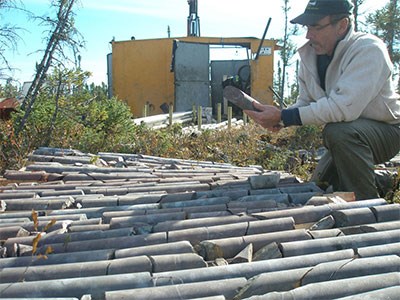As the Ontario government sifts through three separate Ring of Fire road proposals, mine and railroad developer KWG Resources has now posted a preliminary plan of its own.
The Toronto exploration firm has decided to make public a once-confidential east-west access road study, outlining a permanent road to the Ring of Fire that would link four remote First Nation communities along the way.
The 2013 report was prepared by Green Forest Management of Thunder Bay.
Their proposed 305-kilometre gravel road begins northeast of Pickle Lake and tracks eastward toward the mineral deposits of the Ring.
The projected costs range between $83.6 million to $99.9 million. Annual maintenance costs are pegged between $4.2 million and $6.1 million.
Branch roads would connect to the First Nations communities of Eabametoong, Neskantaga, Webequie and Marten Falls at a cost range of between $36.1 million and $73.1 million, depending on the road alignments selected. The annual costs to maintain approximately 200 kilometres of community roads would be between $1.4 million and $2.6 million.
“We had this report prepared in 2013 to scope out the most rational options available to supply our railroad construction and address local aspirations,” said KWG president Frank Smeenk in an Aug. 26 statement.
“While we shared it extensively on a confidential basis, it’s a very practical approach has not yet found traction, so we thought it timely to make the study public now as we prepare to discuss railroad construction financing options. The road network considered here is a desirable, if not indeed an absolutely necessary first step to opening this area development cornucopia and starting to create quite a few ongoing local jobs throughout the entire region.”
Publicity-hungry KWG, 30 per cent owners of the Big Daddy chromite deposit, has made waves in striking agreements to conduct a Ring of Fire rail feasibility study for its development partner, China Railway First Survey & Design Institute, and has discussed off-take supply agreements to Chinese customers.
The company also hit the social media scene this summer with a racy and viral promotional video showing bikini-wearing models.
Among the challenges identified in the Green Forest report was the difficulty of road construction over the northwestern Ontario terrain and in finding sources of road building material and aggregate the closer one gets to the James Bay lowlands.
“Aggregate sourcing and importation is expected to be one of the higher cost components,” said the report.
The consultants cautioned against using the existing winter road network “unless it is absolutely necessary or unavoidable” since these roads are located in low, wet areas.
Green Forest recommends taking the more direct route to the Ring of Fire, maximize the use of high ground and nearby available road building material, and avoid swamp and muskeg as much as possible.
KWG said adding more roads to Nibinamik, Kingfisher Lake, and Wunnumin Lake are feasible but required further research.
The pressure is building on Queen’s Park and Ottawa to make a joint funding announcement this fall that will fund the development of the infrastructure, expected to get underway in 2018.
Other east-west road studies have been filed for the province to review and coalesce into one comprehensive plan to satisfy industry, First Nations and get activity moving in the remote James Bay exploration camp.
Noront Resources has tabled its own proposal of a 280-kilometre-long road, following the winter road network, extending east from the provincial highway system at Pickle Lake, while the engineers at Hatch Mott MacDonald prepared a confidential report for the province.
Last year, the Ring of Fire communities of Webequie, Eabametoong, Neskantaga and Nibinamik received a combined $732,000 from the federal and provincial governments to conduct a regional community service corridor study. The substance of that report – calling for more study – has been released to select media outlets.




